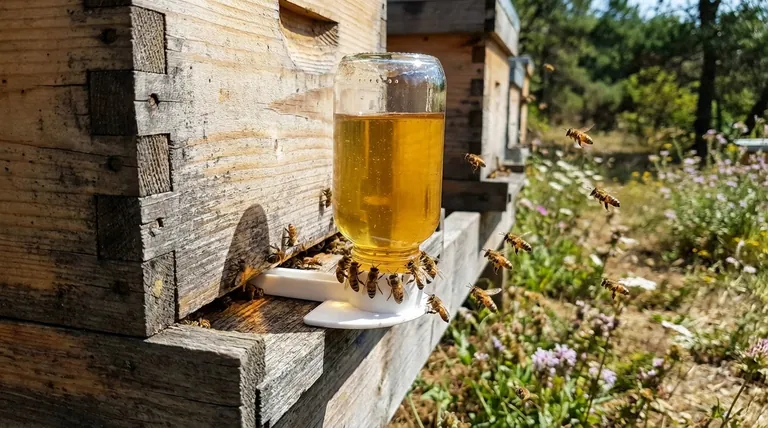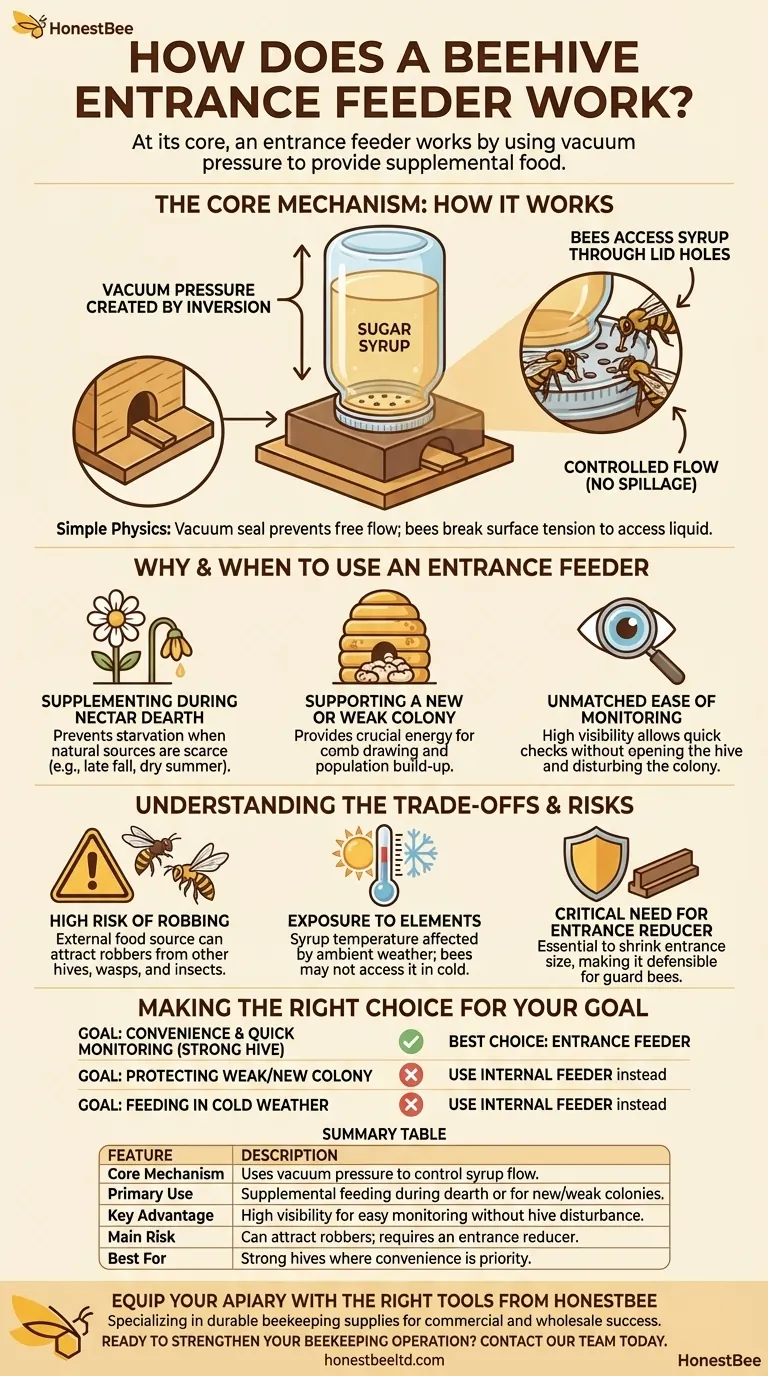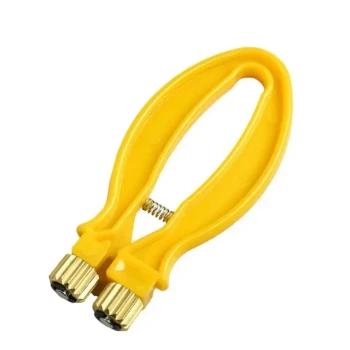At its core, an entrance feeder works by using vacuum pressure. It consists of an inverted jar of sugar syrup with small holes in the lid, which is placed into a tray that slides into the hive's main entrance. The vacuum prevents the syrup from flowing out freely, but allows bees to access the liquid through the holes as needed.
The beehive entrance feeder is a simple, external tool for providing supplemental food. Its primary advantage is convenience and visibility, but this comes at the significant trade-off of potentially attracting predators and robbing bees from other hives.

The Core Mechanism: How It Works
An entrance feeder's design is elegantly simple, relying on basic physics to deliver food without creating a mess or drowning the bees.
The Inverted Jar and Vacuum Seal
The system's foundation is a container, typically a glass jar, filled with sugar syrup and sealed with a lid containing several small perforations.
When this jar is inverted, the weight of the syrup creates a vacuum inside. This pressure holds the liquid in place, preventing it from pouring out through the holes.
Access Through the Lid
Bees access the syrup by inserting their tongues (proboscis) through the holes in the lid.
Each time a bee drinks, it breaks the surface tension and releases a tiny amount of liquid, ensuring a controlled and steady supply without spillage.
Placement at the Hive Entrance
The feeder is designed to sit directly at the hive's entrance, with a wooden or plastic base that slides partially into the hive.
This allows the colony's bees to access the food source from inside the hive, minimizing their need to travel far, especially during poor weather.
Why and When to Use an Entrance Feeder
Feeders are not a permanent fixture; they are a management tool used to support a colony's health at critical times.
Supplementing During a Nectar Dearth
The most common reason to feed bees is during a nectar dearth—a period when natural flower and nectar sources are scarce, such as late fall or a dry summer.
Feeding prevents the colony from consuming all its winter stores or, in a worst-case scenario, from starving.
Supporting a New or Weak Colony
A newly installed package of bees or a weaker colony may not have the foraging workforce necessary to gather enough resources.
Supplemental feeding provides the crucial energy they need to draw out comb, raise brood, and build up their population.
Unmatched Ease of Monitoring
The key advantage of an entrance feeder is its visibility. A beekeeper can see exactly how much syrup is left with a quick glance from a distance.
This avoids the need to open the hive, which disturbs the colony and releases heat.
Understanding the Trade-offs and Risks
While convenient, the entrance feeder is not without significant downsides that require careful management.
The High Risk of Robbing
Placing a food source on the "front porch" of the hive is like an open invitation to outsiders.
Bees from stronger neighboring hives, as well as wasps and other insects, can be attracted to the scent, leading to a "robbing" frenzy. Robber bees will fight the colony's guard bees to steal the food, a conflict that can destroy a weaker hive.
Exposure to the Elements
Because the feeder is outside the hive, the syrup is exposed to ambient temperature changes. On cold days, bees may be unwilling to break cluster to access it, and on very hot days, the syrup can ferment more quickly.
The Critical Need for an Entrance Reducer
Using an entrance feeder makes the hive's entrance a point of contention. To mitigate robbing, it's essential to use an entrance reducer.
This small block of wood shrinks the size of the entrance, making it a smaller, more defensible area for the colony's guard bees to protect against intruders.
Making the Right Choice for Your Goal
Selecting a feeder depends entirely on your colony's strength and your specific goals.
- If your primary focus is convenience and quick monitoring of a strong hive: The entrance feeder is an excellent, efficient choice.
- If your primary focus is protecting a weak or new colony: An internal feeder (placed inside the hive) is a much safer option as it eliminates the risk of robbing.
- If your primary focus is feeding during cold weather: An internal feeder is superior, as the bees can access it without being exposed to the cold outside air.
Understanding how your tools affect bee behavior is the key to responsible and effective beekeeping.
Summary Table:
| Feature | Description |
|---|---|
| Core Mechanism | Uses vacuum pressure from an inverted jar to control syrup flow. |
| Primary Use | Supplemental feeding during nectar dearth or for new/weak colonies. |
| Key Advantage | High visibility for easy monitoring without opening the hive. |
| Main Risk | Can attract robbers (other bees, wasps); requires an entrance reducer. |
| Best For | Strong hives where convenience and quick checks are the priority. |
Equip Your Apiary with the Right Tools from HONESTBEE
Choosing the correct feeder is crucial for colony health and productivity. Whether you manage a few hives or are a large-scale commercial apiary, having reliable, high-quality equipment makes all the difference.
At HONESTBEE, we specialize in supplying durable beekeeping supplies and equipment through our wholesale-focused operations. We help commercial beekeepers and equipment distributors succeed by providing the tools needed for efficient and effective hive management.
Ready to strengthen your beekeeping operation? Contact our team today to discuss your needs and discover how our products can support your success.
Visual Guide

Related Products
- HONESTBEE Entrance Bee Feeder Efficient Hive Front Liquid Feeding Solution for Beekeeping
- Professional Hive Front Entrance Bee Feeder
- Boardman Entrance Bee Feeder Durable Galvanized Steel and Wood Construction for Beekeeping
- HONESTBEE Entrance Bee Feeder Professional Hive Nutrition Solution for Beekeeping
- Classic Boardman Entrance Bee Feeder Hive Front Feeding Solution
People Also Ask
- What strategy was used to eliminate summer migration in the Sierra foothills? Proactive Feeding Based on Brood Signals
- How does the entrance feeder method work? A Guide to Simple But Risky Hive Feeding
- What is an entrance feeder? A Guide to Its Simple Design and High Robbing Risk
- What are the different types of honey bee feeders? Choose the Right Feeder for Your Hive
- How to make an entrance feeder for bees? A DIY Guide for Safe & Effective Feeding



















